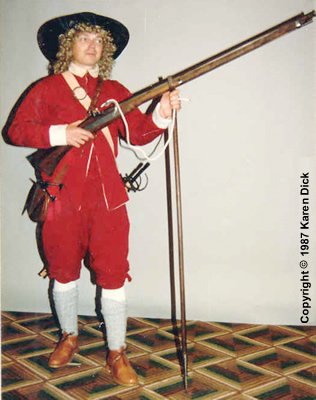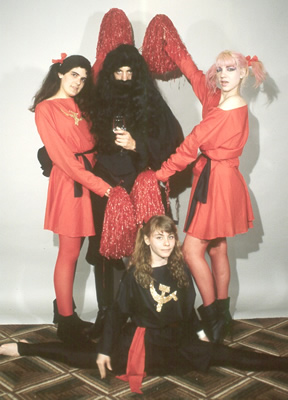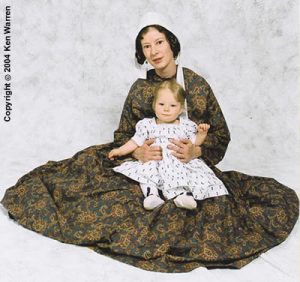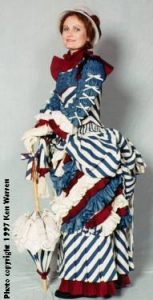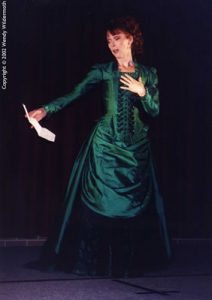CC05-H-HI-16: Rasputin
CC05-H-HI-16: Rasputin | Division: Master | Category: Hist. Interpretation | Designer(s): Animal X, Susan de Guardiola, Wendy Weigert and Eric Blackburn | Maker(s): Animal X, Susan de Guardiola, Wendy Weigert and Eric Blackburn | Presenter(s): Animal X, Susan de Guardiola, Wendy Weigert and Eric Blackburn | Presentation Award(s): The People's Democratic Award: "Comes the Revolution - Finished on Time and Politically Correct" (Photo ID: Karen Schnaubelt | Event Date: 1987)
Competition Staff & Rules
Historical Reproduction Masquerade Rules and Divisions AND Historical Interpretation Masquerade Rules and Divisions
Historical Reproduction Masquerade Staff:
- Masquerades: Elaine Mami
- Master of Ceremonies: Marty Gear‡
- Workmanship Judge: Mary Denise Smith
- Presentation Judges: Kathi Reynolds‡, John Symborski, Lynn Symborski
Historically Accurate: Masquerade Rules And Divisions:
Historical Reproductions – Carefully researched, documented and patterned costumes sewn and presented with period mannerisms in mind, complete from head to toe and “from the skin out”. They range from the menial worker to the nobility — all a challenge.
Costume Con 5’s Historical Masquerade will be organized using the same rules as CC4 as formulated by Victoria Ridenour, with minor changes. These changes are to separate the rules which pertain to Historical Interpretation costumes which will be judged in a separate masquerade following the Historical.
DIVISIONS (Please note: These are slightly different from the SF/F Divisions.)
Novice – A person with no previous award at any competition; a first entry in a historical competition with some experience in another field of costuming; a first entry in any competition.
Journeyman – A costumer who has won major awards in another field of costuming but has little or no experience in historical costuming; has taken a Novice award but has won less than three times at previous Costume Con Historical masquerades; a historical costumer with no professional experience or major awards in previous historical masquerades.
Master – Has professional historical costuming experience; has won major awards in historical competitions; has won three or more major awards at previous Costume Cons.
Costumes in this masquerade will be carefully examined in a prejudging session before the masquerade, so that details of garments which may be lost on stage will receive recognition. The entries will be scored according to the following point system:
0 – Blatantly modern or inaccurate.
1 – Period elements incorrectly combined (i.e., inappropriate mix of time, culture.)
2 – Looks authentic on surface, but has inauthentic elements in design, color, fabric, undergarments, fabric, etc. (“Theatre costume” – e.g. fake underlayers, etc.)
3 – Authentic in look and feel; attempt to reproduce original fabrics and imitate period techniques.
4 – Same as #3 plus special effort to achieve total period effect: e.g., all hand sewn, hand done embellishment, accessories made by the entrant, presented with movement and manners correct for the period.
DOCUMENTATION
0 – No documentation or very inaccurate.
1 – Minimum information listing time, place and pattern source.
2 – Same as 1 with xeroxes but no additional detail.
3 – Same as 1 with additional detail including, at least, specified examples, primary sources, and rationale for fabric, color, and design of major elements of garment and construction.
4 – Same as 3 plus rationale for all elements of the costume, including minor details; a display of understanding of general style of the period represented; explanation of any deviations from the period norm.
The success of the attempt in each of the following categories will be ranked from 0-6.
WORKMANSHIP
Technical – Seam finishing, stitching, neatness.
Fit – Does it hang correctly; move and fit appropriate to the period and style?
Handling of fabric – Choice, use of nap, print, bias, etc.
Consruction details – Interfacing, smocking, pleating details, linings, etc., as appropriate.
COMPLEXITY (This applies to the scope of the project attempted rather than the workmanship.)
Scope of project – The number of pieces, size in relation to detail, etc.
Variety of techniques used.
Difficulty of techniques attempted.
Extent of original pattern work.
RULES AND REGULATIONS GOVERNING PRESENTATIONS, LABELLING TAPES, TIME LIMITS AND THE WEAPONS POLICY THAT APPLY TO THE SCIENCE FICTION/FANTASY MASQUERADE ALSO APPLY TO THE HISTORICAL AND THE HISTORICAL INTERPRETATION MASQUERADES.
Forms for all masquerades will be at the convention registration table. You are required to turn them in for the Historical Masquerade along with any cassette you want played for your presentation by 3:00pm Sunday. As with the SF/F masquerade, there will be no live mikes available for the contestants use. PLEASE BRING YOUR DOCUMENTATION WITH YOU TO THE GREEN ROOM ON SUNDAY EVENING. Reporting time for the Green Room will be announced in the next progress report.
General note – No costume may be entered in more than one Masquerade. Also – costumes worn in the halls before the masquerades are not eligible to be entered into competition.
Historical Interpretation Masquerade Staff:
- Masquerades: Elaine Mami
- Master of Ceremonies: Bobbi Gear‡
- Workmanship Judges: Mary Denise Smith
- Presentation Judges: Kathryn Condon, jan howard finder‡, Mary Stasheff
Rules:
Historical Interpretation: Masquerade Rules And Divisions:
[Addendum and clarification – One of the main differences between Historical Interpretation and Historical Reproduction costumes is the attention to detail “from the skin out”.
Therefore, if a contestant re-creates a costume from a media source and is as accurate to that source as possible, they may qualify to enter the Historic Reproduction Masquerade, as long as appropriate documentation is provided.
EXAMPLE – If, in doing a costume from the 1938 film MARIE ANTOINETTE, the costumer uses the same type of foundation garments as were used by the movie studio in making the picture, that would qualify as being historically accurate – for the 1930’s.]
Historical Interpretation – Costumes from any period, re-created from television, stage, film, [artist’s] rendering, illustration, etc., which is a conceptive interpretation rather than a technically accurate reproduction of historic clothing.
(It is not necessary to re-create “from the skin out”, for these costumes.)
DIVISIONS AND RULES
The Historical Interpretation Masquerade will be run on the same division system as the SF/F Masquerade (see PR#1).
The judging criteria will parallel that which is done for the Re-creation class of the SF/F Masquerade. Again – it is necessary that you have some kind of [pictorial] documentation to show what design you are interpreting.
In the Black and White category of the first section of this masquerade contestants are urged to give a short explanation as to why they interpreted the colors as they have.
You will be judged on the accuracy with which you have re-created the original and its accoutrements – shoes, hair, headpieces, etc. Additional points can be gained by characterization.
Category 2 in this masquerade is a catch-all for those costumes which do not easily fit in any of the others (see definition in PR#1). It should not be used unless you are absolutely sure that your costume belongs nowhere else.
Anyone who is crazy enough may enter both the Historical Reproduction and the Interpretation Masquerades. We ask only that you identify yourself at the masquerade registration table so we can position you accordingly.
General note – No costume may be entered in more than one Masquerade. Also – costumes worn in the halls before the masquerades are not eligible to be entered into competition.
—
Miscellaneous Notes: All Best in Show entries received, in addition to certificates, The Dictionary of Costume. Best Workmanship entries in each masquerade received the 18th Century Woman catalogue from the Metropolitan Museum’s exhibition.
